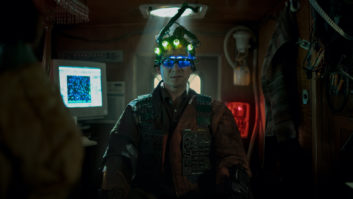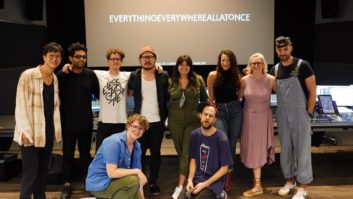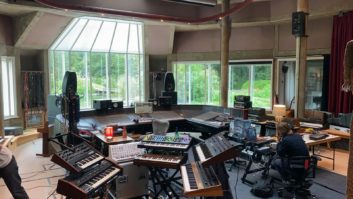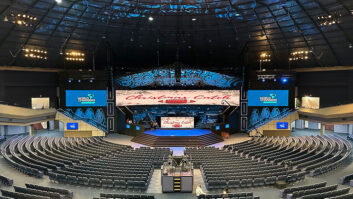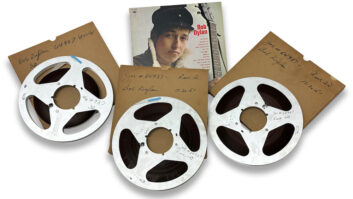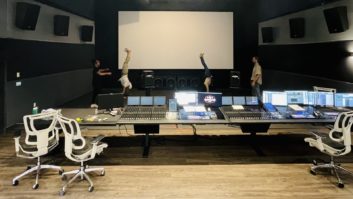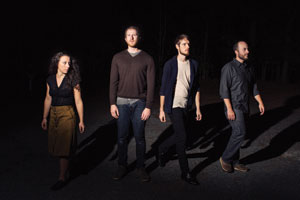
Lost in the Trees leader Ari Picker thought he had a well-thought-out map for his band’s latest ethereal prog-folk album, Past Life (Anti). For previous releases, such as A Church That Fits Our Needs (The Wall Street Journal’s pick for best album of 2012), he says writing happened “in my room, huddled up and isolated. My influences were obscure, and my process was homespun.” He’d then take his demos into a studio and teach parts to his bandmates as they recorded.
This time out, Picker and band developed full-blown arrangements of the songs and toured the East Coast with them before going into the Neve 8068-equipped Echo Mountain Studios (Asheville, N.C.) with producer/engineer Nicolas Vernhes (Deerhunter, Call of the Wild) to record.
“We had a pretty good idea of what we wanted to do, but Nicolas pushed us to take things further, or dismantle things,” Picker says. “We became fascinated with minimalism and trying to present a song with as few elements as possible. By using less, you’re able to make elements bigger and more present. A lot of songs changed.”
Vernhes is also a musician and studio owner, and he says he opened his facility (Rare Book Room, NYC) because the experimental bands he knew often didn’t have enough money and time in the studio to take their musical vision as far as they wanted. He wants artists to feel like they always have plenty of time to invent.
“As soon as I heard Lost in the Trees, I was taken by the melodic work, instrumentally and vocally,” Vernhes says. “There’s a lot of very complex vocal interplay that I was drawn to.”
Vernhes hit on the idea of showcasing Picker’s melodies with instruments layered very delicately, and often peeling away to highlight one vocal tone or one vocal-and-keyboard line.
“The song ‘Lady in White,’ the third track on the record, started as a rock song—full on guitars, and I was kind of yelling the vocals,” Picker explains. “Nicolas took out the drum patterns and the guitars completely, and what was left was the piano line and strings. We basically took out the middle of the song and left only low end and a sparkling piano on top. The vocals became much more serene, and it definitely captured the more haunting aspect of the song, which would have been covered up if we had left all the rocking guitars.

Nicolas Vernhes (left) and Ari Picker at Echo Mountain.
“Then we had Kyle [Keegan] play each of the drums separately,” Picker continues. “Now it sounds like a beat machine behind the track, even though it’s him playing; it has this weird in-between human-robot feel.”
“We close miked each drum with towels on almost every drum, covering maybe half the head and moving each one until it had just the right amount of decay and attack,” says Vernhes, who tracked the sessions to Pro Tools but says that most instruments hit Echo Mountain’s Studer A800 MkIII 24-track machine at some point. “We were actually trying to make the drums sound processed without actually processing them, just by taking a little extra time while we were setting up mics.”
The string section on many of the tracks (two violins, two cellos, one viola) adds drama to these pared-down arrangements, as do some otherworldly sounds that came from recording familiar instruments in unconventional ways.
“One thing we used a lot was the Hammond B3, but often not in the traditional B3 manner of having it heavily chorused, coming through the Leslie,” Vernhes explains. “We’d turn the Leslie off, and any other type of chorusing, so we’d just hear a pure sine wave. But we did sometimes put [Emma Nadeau’s] Fender Rhodes through the Leslie; that’s got a different kind of attack from the organ, and it doesn’t have the same continuous tone. After a few seconds, there’s a natural decay, which is always interesting. We put some of [Picker’s] guitars through there, as well.”
To capture the B3, Vernhes put a pair of Shure SM57s on the horns and a Neumann 47 FET on the bottom. “We didn’t really want to get a lot of really deep low end from it,” he explains. “We were very specific about what we wanted from specific instruments: That instrument’s going to be the midrange; we want no bright top and nothing low from it. We wanted individual elements to occupy a space without treading on anything else.”
Whereas many of the instrument sounds on Past Life were deconstructed to create that “human-robot feel,” Picker’s elegant voice is a very personal, carefully orchestrated element in each song.
“Ari has really interesting tone and a lot of control over his voice so he can make it sound different ways, and it would have been wrong to use the same vocal mic on every track,” says Vernhes. He put up a Neumann U 67 for some songs, an AKG C12 for others, “and for some we would mix and match, and use both,” the producer says. “I’d put a close mic, the 67, and then two or three feet away I’d put the C12 as a room mic and compress that a bit more so it would be very airy.
“Echo Mountain is an old church with tall ceilings, wood paneling and a wood floor, and we’d have Ari singing out in the chapel. It’s a beautiful space acoustically, as well as visually.”
